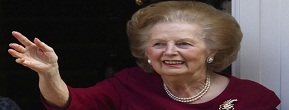Thatcher, UK’s Iron Lady, dies of stroke at age of 87
 Britain’s first and only female Prime Minister Margaret Thatcher nicknamed as ‘Iron Lady’ has died of stroke at the age of 87, local media reported.
Britain’s first and only female Prime Minister Margaret Thatcher nicknamed as ‘Iron Lady’ has died of stroke at the age of 87, local media reported.
Her children Mark and Carol Thatcher announced that their mother had died peacefully following a stroke this morning.
Margaret Thatcher was transformed from Grantham grocer’s daughter to 10 Downing Street, where she served as Prime Minister from 1979 to 1990.
After winning a scholarship to Oxford, where she read chemistry, Margaret Roberts became fascinated by politics.
She was highly inspired by her father, who had been a councillor in Grantham, to try to secure a candidacy to be a Conservative MP.
In 1950 and 1951 elections, she made an attempt to win the safe Labour seat of Dartford, but in failure. However, if unsuccessful in politics, Margaret made a success in love in Dartford, when in 1951 she met and married her future husband, Denis Thatcher. They married, when she was 26 and he 36, and two years later she gave birth to twins, Carol and Mark.
In 1959, Margaret Thatcher was adopted for the Conservative seat of Finchley, and was returned to parliament for the first time at the election of that year. She held the seat until her retirement from the Commons in 1992.
In 1967, Conservative Party’s chief Edward Heath invited her to join his shadow cabinet and made her education secretary following his unexpected triumph over Harold Wilson in the 1970 general election. Margaret Thatcher was elected Conservative Party Leader in 1975.
By the end of March 1979, when the Callaghan government finally lost a Commons vote of confidence, and with the disaster of the Winter of Discontent still fresh in the memories of millions of Britons, Margaret Thatcher won the election on May 3 comfortably, ending up with an overall majority of 43.
Thatcher stormed into Downing Street on May 4, 1979, following a Conservative election campaign which focused on the economic paralysis of the nation during the so-called Winter of Discontent.
After becoming prime minister, Thatcher put reforming trade unions and restructuring the British economy top on her government’s agenda.
The structural change meant that millions were put on the dole, unemployment rising by 1982 to its highest - at over three million - since the slump of the 1930s. The Thatcher government, and notably its chief, became seriously unpopular.
When Argentina launched an attack to recapture Las Malvinas (the Falkland) Islands in April 1982 many thought that Britain either would not, or could not regain the already occupied territory.
However, for Margaret Thatcher, the Argentines were the most useful enemy, because when the Falklands war started Thatcher was still struggling with the consequences of the economic restructuring, and was enormously out of favour with the electorate. By the end of it she was a heroine to many and her victory at the next election was assured.
The second Thatcher mandate, with a Commons majority of 144, was enough to pursue even more radical reforms than in the first term.
By the time Thatcher won her third mandate in June 1987 she was considered as a go-between for her old friend [former U.S. President] Ronald Reagan with her new friend [former Soviet Union President] Mikhail Gorbachev, and with an eye to winning the Cold War.
Britain’s so-called ‘Iron Lady’ left Downing Street on November 28, 1990, in tears, for the last time. The "Iron Lady", as she was nicknamed, was a deeply divisive figure, openly hated by many, especially those from industrial heartlands, which she sent to the wall.
She ended her 11-year premiership quite literally in tears, thrown out not by the voters but by the very Conservative MPs she had led to three successive general election victories.
Add new comment